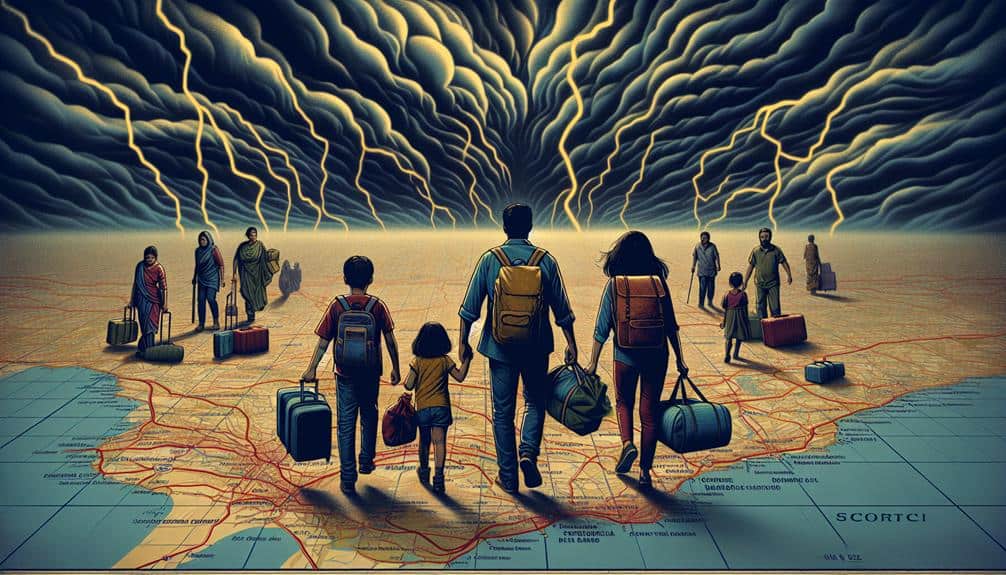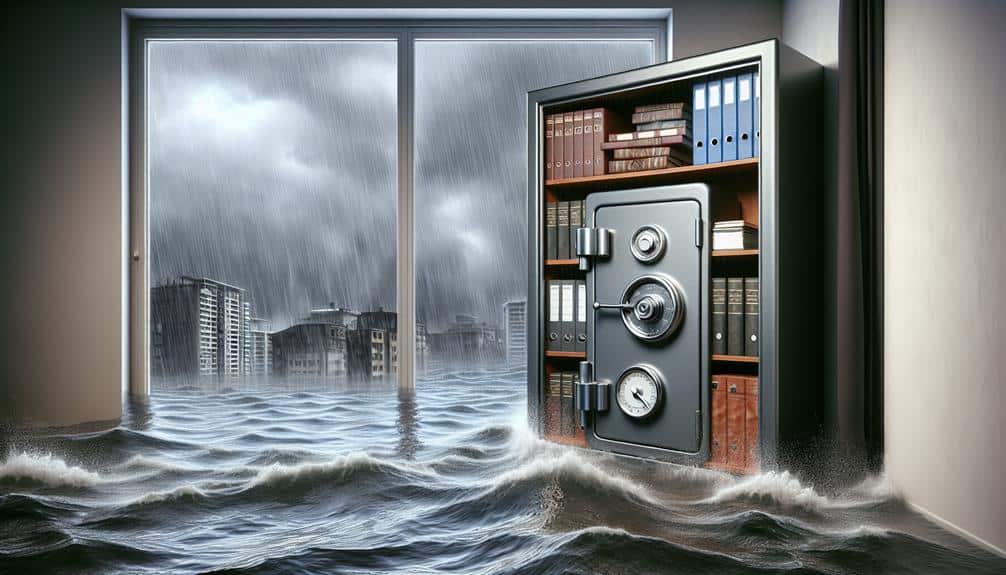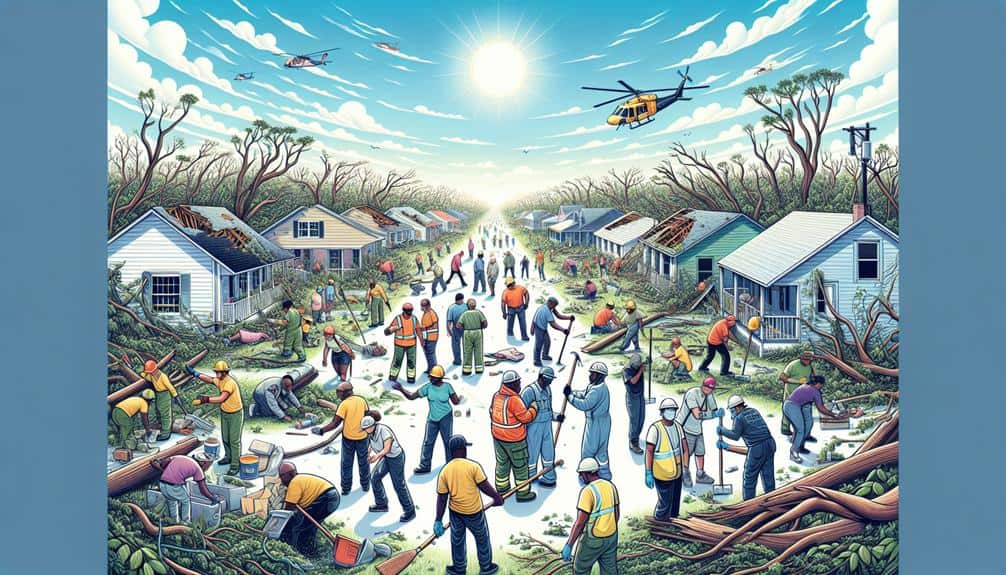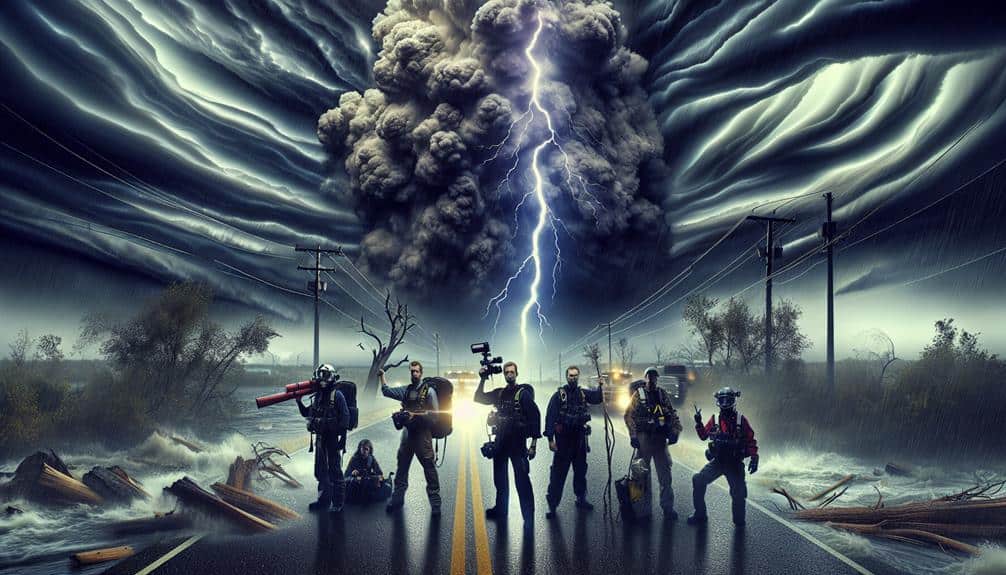We must actively employ proven strategies to maximize safety during strong hurricanes. We need to prepare an emergency kit with a three-day supply of essentials as recommended by FEMA. Securing our home with storm shutters and anchoring outdoor furniture reduces hazards. Planning evacuation routes in advance ensures swift, safe departures, potentially reducing fatalities by up to 80%. Staying informed via emergency alerts and reliable sources like the National Hurricane Center is important. Protecting important documents in waterproof containers, planning for pets' safety, and conducting post-storm inspections are essential for overall safety. By following these steps, we can greatly enhance our preparedness and resilience.
Key Points
- Prepare an Emergency Kit with three days' supply of food, water, and first aid essentials per person.
- Secure windows and doors with storm shutters or plywood to protect your home.
- Plan and familiarize yourself with evacuation routes well in advance.
- Monitor real-time updates from reliable sources like the National Hurricane Center.
Prepare an Emergency Kit
Why do we need an emergency kit? During a hurricane, our primary goal is to ensure safety and survival. An emergency kit serves as our lifeline, supplying essential items such as food supplies and first aid to sustain us when access to resources is limited. Data shows that hurricanes can disrupt infrastructure for days, even weeks, making it essential to be self-sufficient.
Having non-perishable food supplies, like canned goods and energy bars, guarantees we've the necessary caloric intake. According to the Federal Emergency Management Agency (FEMA), a three-day supply of food and water per person is recommended for hurricane preparedness. This helps us avoid the chaos and scarcity that often follow a hurricane.
First aid is another vital component of our emergency kit. Injuries are common during hurricanes, so having a well-stocked first aid kit can be a game-changer. Essential items include bandages, antiseptic wipes, and pain relievers.
Research indicates that timely first aid can prevent minor injuries from becoming severe, which is essential when medical assistance may be delayed.
Secure Your Home
Let's fortify our homes by strengthening windows and doors with storm shutters or plywood. This can reduce wind penetration by up to 50%.
Anchoring outdoor furniture and other objects minimizes projectiles that can cause structural damage.
Data shows that taking these measures notably boosts our home's resilience against hurricane-force winds.
Reinforce Windows and Doors
Securing our homes against powerful hurricanes necessitates the use of storm shutters or impact-resistant windows to protect against high winds and flying debris.
Window shutters, such as accordion or roll-down types, can withstand wind speeds exceeding 150 mph, offering a strong defense mechanism. Additionally, impact-resistant windows, designed with laminated glass and reinforced frames, prevent shattering and maintain structural integrity under pressure.
Door reinforcement is equally vital. Standard doors are vulnerable, but installing heavy-duty deadbolts and adding door braces can greatly enhance their resistance.
For garage doors, which are often the weakest point, retrofitting with a bracing kit or replacing with a wind-rated model can prevent catastrophic failure. Research indicates that garage doors are responsible for about 80% of home damage during hurricanes, so this step is crucial.
Anchor Outdoor Furniture
While fortifying windows and doors strengthens our home's defenses, securing outdoor furniture is equally crucial to prevent projectiles during a hurricane.
Unsecured items can become hazardous, leading to potential damage to structures or harm to individuals. Here are three essential steps to maximize the security of our outdoor spaces:
- Stabilize plants: Potted plants and gardening equipment should be relocated indoors or placed in a secure storage area. If bringing them inside isn't practical, use heavy-duty straps or ropes to fasten them down. This reduces the risk of them becoming airborne.
- Fasten furniture: Patio furniture, including chairs, tables, and umbrellas, should be fastened using ground stakes or weighted bases. For items that can't be secured, consider storing them in a garage or shed. Data shows that tethered furniture reduces the likelihood of damage by 85%.
- Shield pool: A sturdy pool cover can prevent debris from entering and damaging the pool. It also prevents loose items from becoming submerged and later turning into hazards. Choose covers that are rated for extreme weather conditions for best protection.
Know Evacuation Routes

We must plan our evacuation routes well in advance of any hurricane threat to guarantee a swift and safe departure.
Utilizing local authority resources, such as maps and alerts, allows us to stay informed about the most efficient routes and potential hazards.
Data from previous hurricanes indicate that early planning markedly reduces evacuation times and increases safety.
Plan Ahead Early
Understanding evacuation routes well in advance can greatly improve our ability to respond efficiently during a hurricane emergency. Early planning is essential to guarantee our safety and the safety of our loved ones. By familiarizing ourselves with the designated evacuation routes, we can minimize confusion and delays when a hurricane strikes.
Effective evacuation planning involves several key steps:
- Study Maps and Routes: Obtain local maps and mark the primary and secondary evacuation routes. Knowing multiple paths can be lifesaving if roads become impassable.
- Emergency Communication: Establish a reliable communication plan with family and friends. Make sure everyone knows how to contact each other and where to meet if separated.
- Check Supplies and Vehicle Readiness: Regularly inspect your vehicle to confirm it's in good working order. Stock it with essential supplies such as fuel, water, and first-aid kits.
Scientific studies indicate that early evacuation reduces stress and improves survival rates. Data from the National Hurricane Center shows that timely evacuation can decrease fatalities by up to 80%.
Let's embrace our freedom to choose safety by planning ahead. The proactive steps we take today can make a significant difference in our ability to navigate through the chaos of a hurricane efficiently.
Local Authority Resources
Local authorities provide essential resources, including detailed maps and real-time updates, to help residents navigate evacuation routes efficiently during hurricanes. By leveraging Geographic Information Systems (GIS) and other digital tools, they enable us to identify the safest paths to designated shelters. These maps often highlight various shelter options, ensuring that we can find refuge close to our current location.
Effective communication strategies are necessary for a successful evacuation. Local authorities disseminate information through multiple channels such as social media, emergency broadcast systems, and dedicated apps. Staying informed helps us make timely decisions and avoid congested routes.
It's crucial to have a list of emergency contacts readily available, including local emergency management offices and community support centers, which can provide guidance and resources during the evacuation process.
Community support is another vital element. Local authorities often coordinate with community organizations to offer assistance to vulnerable populations, ensuring no one is left behind. They may also organize transportation for those without means, guaranteeing equitable access to safety.
Stay Informed
Staying informed about hurricanes requires regularly monitoring updates from reliable sources such as the National Hurricane Center and local meteorological services. By staying on top of weather updates, we can make timely decisions that guarantee our safety and autonomy.
Understanding emergency alerts is essential. These alerts provide real-time data on storm trajectories, wind speeds, and potential hazards.
To fully leverage these updates, we should:
- Subscribe to Alerts: Sign up for emergency alerts from trusted organizations like FEMA and local emergency management agencies. These alerts can be received via SMS, email, or dedicated apps.
- Use Weather Apps: Install weather apps that offer real-time tracking and detailed forecasts. Apps like NOAA Weather Radar and AccuWeather provide precise storm paths and intensity updates.
- Monitor Social Media: Follow official meteorological and emergency services on platforms like Twitter and Facebook for the latest advisories and community updates.
Engaging with these resources empowers us to make informed decisions and maintain our freedom to act swiftly. Accurate, timely information is our best defense against the unpredictable nature of hurricanes.
Protect Important Documents

While staying informed equips us with critical knowledge, safeguarding important documents secures that we can recover and rebuild effectively after a hurricane. Securing document protection involves both physical and digital strategies.
First, let's gather all essential documents like birth certificates, social security cards, insurance policies, and medical records. Place these in waterproof, fire-resistant containers to mitigate risks from flooding or fire.
To further reinforce our preparedness, we should employ digital backups. By scanning and storing these documents on secure cloud services, we create redundancy that guarantees access even if physical copies are lost. According to FEMA, 40-60% of small businesses never reopen after a disaster, often due to loss of critical documents. Digital storage solutions, like encrypted cloud services, offer a robust safeguard.
Additionally, we can utilize external hard drives as a secondary backup, maintaining them in a separate, secure location. This dual-layer approach—combining physical and digital backups—maximizes document protection and minimizes downtime post-disaster.
Plan for Pets
Ensuring the safety of our pets during a hurricane demands meticulous planning and adherence to established guidelines. We can't afford to overlook the specific needs of our furry companions when preparing for such extreme weather events.
First and foremost, we should identify local pet shelters that can accommodate pets during emergencies. Some shelters may not accept animals, so knowing which ones do is essential.
Next, let's evaluate our evacuation options. We need to research pet-friendly hotels and motels along our planned evacuation routes to make sure we won't be turned away at critical times. Additionally, having a reliable list of emergency contact numbers, including veterinarians and animal control officers, can be life-saving.
Here are three essential steps to follow:
- Assemble a Pet Emergency Kit: Include food, water, medications, and a portable crate or carrier.
- Microchip and ID Tags: Confirm our pets have up-to-date identification to increase the chances of reunification if separated.
- Evacuation Drills: Practice loading pets into carriers and vehicles quickly to reduce stress during the actual event.
Post-Storm Safety

After securing our pets and safeguarding they're safe, we need to focus on evaluating structural damage to our homes and properties to prevent further hazards post-storm. First, let's inspect roofs, walls, and foundations for any signs of compromise. Utilize tools like moisture meters and infrared cameras to detect hidden water damage.
It's essential to shut off utilities like gas and electricity if we suspect any leaks or exposed wires to prevent fires or explosions.
Next, document all damages with photos and detailed notes for insurance claims. This data-driven approach ensures we've accurate records. Let's also be mindful of our mental health during this stressful period. Engaging in regular check-ins with family and friends can alleviate anxiety and provide emotional support.
Community support is crucial; collaborating with neighbors can expedite recovery efforts. Share resources like generators or water pumps, and participate in neighborhood clean-up initiatives. We should also pay attention to local advisories and updates from emergency services to stay informed about ongoing risks.
Frequently Asked Questions
How Can I Help Neighbors Who Might Need Assistance During a Hurricane?
When the storm rages, we become the lighthouse for our community. Let's organize neighborly assistance, coordinate emergency response, and focus on data-driven relief efforts. Together, we can guarantee robust community support and safeguard everyone's freedom.
What Should I Do if I'm Caught Driving During a Hurricane?
If we're caught driving during a hurricane, we should seek shelter immediately in a sturdy building. We must have emergency kits ready, including water, non-perishable food, and first-aid supplies. Data shows this maximizes survival rates.
Are There Special Considerations for People With Disabilities During a Hurricane?
We must guarantee accessible shelters are available and stock emergency supplies tailored to specific needs. Data indicates that individuals with disabilities face higher risks, so thorough preparation and community support are essential for their safety and freedom.
How Can I Protect My Mental Health During a Hurricane?
When the storm's fury overwhelms, we can safeguard our mental health by practicing coping strategies. Prioritize self-care to maintain emotional well-being. Techniques like mindfulness, staying connected, and accessing mental health resources are crucial for resilience.
What Steps Should I Take if I Lose Power for an Extended Period?
During a power outage, we should prioritize food safety by using coolers and ice packs. Maintain communication with emergency contacts using battery-powered devices. Data shows preserving food and staying connected greatly enhances our resilience and independence.


